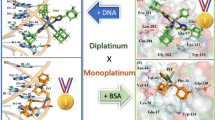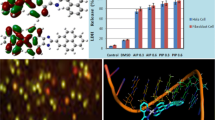Abstract
The synthesis and characterization of four platinum(II) complexes using azobenzenes conveniently functionalized as ligands has been carried out. The characteristic photochemical behavior of the complexes due to the presence of azobenzene-type ligands and the role of the ligands in the activation of the complexes has been studied. Their promising cytotoxicity observed in HeLa cells prompted us to study the mechanism of action of these complexes as cytostatic agents. The interaction of the compounds with DNA, studied by circular dichroism, revealed a differential activity of the Pt(II) complexes upon irradiation. The intercalation abilities of the complexes as well as their reactivity with common proteins present in the blood stream allows to confirm some of the compounds obtained as good anticancer candidates.













Similar content being viewed by others
References
Worldwide cancer data. Global cancer statistics for the most common cancers. https://www.wcrf.org/dietandcancer/cancer-trends/worldwide-cancer-data. (Accessed 11 May 2020)
Sumit G (2019) Cisplatin: the first metal based anticancer drug. Bioorg Chem 88:102925–102945. https://doi.org/10.1016/j.bioorg.2019.102925
Bai L, Gao C, Liu Q, Yu C, Zhang Z, Cai L, Yang B, Qian Y, Yang J, Liao X (2017) Research progress in modern structure of platinum complexes. Eur J Med Chem 140:349–382. https://doi.org/10.1016/j.ejmech.2017-09-034
Mjos KD, Orvig C (2014) Metallodrugs in medicinal inorganic chemistry. Chem Rev 114:4540–4563. https://doi.org/10.1021/cr400460s
Oun R, Moussa YE, Wheate NJ (2018) The side effects of platinum-based chemotherapy drugs: a review for chemists. Dalton Trans 47:6645–6653. https://doi.org/10.1039/C8DT00838H
Marques MPM, Batista de Carvalho ALM, Mamede AP, Dopplapudi A, Rudic S, Tyagi M, Sakai VG, Batista de Carvalho LAE (2020) A new look into the mode of action of metal-based anticancer drugs. Molecules 25:246–265. https://doi.org/10.3390/molecules25020246
Johnstone TC, Park GY, Lippard SJ (2014) Understanding and improving platinum anticancer drugs-phenanthriplatin. Anticancer Res 34:471–476
Dasari S, Tchounwou PB (2014) Cisplatin in cancer therapy: molecular mechanisms of action. Eur J Pharmacol 7:364–378. https://doi.org/10.1016/j.ejphar.2014.07.025
Bonnet S (2018) Why develop photoactivated chemotherapy. Dalton Trans 47:10330–10343. https://doi.org/10.1039/c8dt01585f
de Boer-Maggard TR, Mascharak PK (2014) Photoactivatable metal complexes and their use in biology and medicine. In: Storr T (ed) Ligand des med inorg chem. John Wiley and Sons Ltd
Zhang Q, Kuang G, He S, Lu H, Cheng Y, Zhou D, Huang Y (2020) Photoactivatable prodrug-backboned polymeric nanoparticles for efficient light-controlled gene delivery and synergistic treatment of platinum-resistant ovarian cancer. Nano Lett 20:3039–3049. https://doi.org/10.1021/acs.nanolett.9b04981
Shi H, Imberti C, Sadler PJ (2019) Diazido platinum(IV) complexes for photoactivated anticancer chemotherapy. Inorg Chem Front 6:1623–1638. https://doi.org/10.1039/C9QI00288J
Morales K, Samper KG, Pena Q, Hernando J, Lorenzo J, Rodríguez-Diéguez A, Capdevila M, Figueredo M, Palacios O, Bayón P (2018) Squaramide-based Pt(II) complexes as potential oxygen-regulated light-triggered photocages. Inorg Chem 57:15517–15525. https://doi.org/10.1021/acs.inorgchem.8b02854
Srivastava P, Singh K, Verma M, Sivakumar S, Patra AK (2018) Photoactive platinum(II) complexes of nonsteroidal anti-inflammatory drug naproxen: Interaction with biological targets, antioxidant activity and cytotoxicity. Eur J Med Chem 144:243–254. https://doi.org/10.1016/j.ejmech.2017.12.025
Reessing F, Szymanski W (2017) Beyond photodynamic therapy: light-activated cancer chemotherapy. Curr Med Chem 24:4905–4950. https://doi.org/10.2174/0929867323666160906103223
Najjar A, Rajabi N, Karaman R (2017) Recent approaches to platinum(IV) prodrugs: a variety of strategies for enhanced delivery and efficacy. Curr Pharm Des 23:2366–2376. https://doi.org/10.2174/1381612823666170201161037
Agent Mitra K, Gautam S, Kondaiah P, Chakravarty AR (2015) The cis-diammineplatinum(II) complex of curcumin: a dual action DNA crosslinking and photochemotherapeutic. Angew Chem Int Ed 54:13989–13993. https://doi.org/10.1002/anie.201507281
Biston M-C, Joubert A, Charvet A-M, Balosso J, Foray N (2009) In vitro and in vivo optimization of an anti-glioma modality based on synchrotron X-ray photoactivation of platinated drugs. Radiat Res 172:348–358. https://doi.org/10.1667/RR1650.1
Farrer NJ, Salassa L, Sadler PJ (2009) Photoactivated chemotherapy (PACT): the potential of excited-state d-block metals in medicine. Dalton Trans 48:10690–10701. https://doi.org/10.1039/B917753A
Fodor L, Ullmann Y, Elman M (2011) Aesthetic applications of intense pulsed light. Springer
O’Hagan MP, Ramos-Soriano J, Haldar S, Sheikh S, Morales JC, Mulholland AJ, Galan M (2020) Visible-light photoswitching of ligand binding mode suggests G-quadruplex DNA as a target for photopharmacology. ChemComm 56:5186–5189. https://doi.org/10.1039/d0cc01581d
Bhattacharyya S, Maity M, Chowdhury A, Saha ML, Panja SK, Stang PJ, Mukherjee PS (2020) Coordination-assisted reversible photoswitching of spiropyran-based platinum macrocycles. Inorg Chem 59:2083–2091. https://doi.org/10.1021/acs.inorgchem.9b03572
Presa A, Vazquez G, Barrios LA, Roubeau O, Korrodi-Gregorio L, Perez-Tomas R, Gamez P (2018) Photoactivation of the cytotoxic properties of platinum(II) complexes through ligand photoswitch. Inorg Chem 57:4009–4022. https://doi.org/10.1021/acs.inorgchem.8b00146
Moustafa ME, McCready MS, Boyle PD, Puddephatt RJ (2017) Photoswitchable and pH responsive organoplatinum(II) complexes with azopyridine ligands. Dalton Trans 46:8405–8414. https://doi.org/10.1039/C7DT01290J
Merino E (2011) Synthesis of azobenzenes: the coloured pieces of molecular materials. Chem Soc Rev 40:3835–3853. https://doi.org/10.1039/C0CS00183J
Gunnlaugsson T, Leonard JP, Murray NS (2004) Highly selective colorimetric naked-eye cu(ii) detection using an azobenzene chemosensor. Org Lett 6:1557–1560. https://doi.org/10.1021/ol0498951
Cardona MA, Makuc D, Szaciłowski K, Plavec J, Magri DC (2017) Water-soluble colorimetric amino[bis(ethanesulfonate)] azobenzene pH indicators: a UV–vis absorption, DFT, and 1H–15N NMR spectroscopy study. ACS Omega 2:6159–6166. https://doi.org/10.1021/acsomega.7b00887
Bandara HMD, Burdette SC (2012) Photoisomerization in different classes of azobenzene. Chem Soc Rev 41:1809–1825. https://doi.org/10.1039/C1CS15179G
Tamai N, Miyasaka H (2000) Ultrafast dynamics of photochromic systems. Chem Rev 100:1875–1890. https://doi.org/10.1021/cr9800816
Tong X, Pelletier M, Lasia A, Zhao Y (2008) Fast cis–trans isomerization of an azobenzene derivative in liquids and liquid crystals under a low electric field. Angew Chem Int Ed 47:3596–3599. https://doi.org/10.1002/anie.200705699
Pratihar JL, Mandal P, Lin C-H (2019) Synthesis, characterization, structure and redox property of azo-amido and orthometalated azo-imine platinum(II) complexes. Polyhedron 173:114102–114106. https://doi.org/10.1016/j.poly.2019.07.047
Samper KG, Marker SC, Bayón P, MacMillan SN, Keresztes I, Palacios O, Wilson JJ (2017) Anticancer activity of hydroxy- and sulfonamide-azobenzene platinum(II) complexes in cisplatin-resistant ovarian cancer cells. J Inorg Biochem 174:102–110. https://doi.org/10.1016/j.jinorgbio.2017.06.003//
El-Gendy BE-DM, Ghazvini Zadeh EH, Sotuyo AC, Pillai GG, Katritzky AR (2013) α-Substitution effects on the ease of S→N-acyl transfer in aminothioesters. Chem Biol Drug Des 81:577–582. https://doi.org/10.1111/cbdd.12092
Wang Y, Song W, Hu WJ, Lin Q (2009) Fast alkene functionalization in vivo by photoclick chemistry: HOMO lifting of nitrile imine dipoles. Angew Chem Int Ed 48:5330–5333. https://doi.org/10.1002/anie.200901220
Shimogaki T, Oshita S, Matsumoto A (2011) Intercalation of mono- and difunctional azobenzenes as photoresponsible guest molecules into poly(muconic acid) host crystals. Macromol Chem Phys 212:1767–1777. https://doi.org/10.1002/macp.201100096
Wen G, Zhang D, Huang Y, Zhao R, Zhu L, Shuai Z, Zhu D (2007) New heterocyclic tetrathiafulvalene compounds with an azobenzene moiety: Photomodulation of the electron-donating ability of the tetrathiafulvalene moiety. J Org Chem 72:6247–6250. https://doi.org/10.1021/jo070651e
Kim J, Novak BM, Waddon AJ (2004) Liquid crystalline properties of polyguanidines. Macromolecules 37:8286–8292. https://doi.org/10.1021/ma0493527
Kreger K, Wolfer P, Audorff H, Kador L, Stingelin-Stutzmann N, Smith P, Schmidt H-W (2010) Stable holographic gratings with small-molecular trisazobenzene derivatives. J Am Chem Soc 132:509–516. https://doi.org/10.1021/ja9091038
AD Ryabov, LG Kuzmina, NV Dvortsova, DJ Stufkens, R van Eldik, Bridging of platinacycles by cis-azobenzenes: synthesis and photochemical study (1993) Structure of the twisted inorganic Z-1,1,2,2-tetrasubstituted diazaethene [(Z)-1,2-diphenyldiazaethene)bis[chloro(((dimethylamino)methyl)phenyl-C,N)platinum(II)]. Inorg Chem 32:3166–3174. https://doi.org/10.1021/ic00066a031
Schroeder GM, An Y, Cai Z-W, Chen X-T, Clark C, Cornelius LAM, Dai J, Gullo-Brown J, Gupta A, Henley B, Hunt JT, Jeyaseelan R, Kamath A, Kim K, Lippy J, Lombardo LJ, Manne V, Oppenheimer S, Sack JS, Schmidt RJ, Shen G, Stefanski K, Tokarski JS, Trainor GL, Wautlet BS, Wei D, Williams DK, Zhang Y, Zhang Y, Fargnoli J, Borzilleri RM (2009) Discovery of N-(4-(2-Amino-3-chloropyridin-4-yloxy)-3-fluorophenyl)-4-ethoxy-1-(4-fluorophenyl)-2-oxo-1,2-dihydropyridine-3-carboxamide (BMS-777607), a Selective and orally efficacious inhibitor of the met kinase superfamily. J Med Chem 52:1251–1254. https://doi.org/10.1021/jm801586s
Zamora A, Pérez SA, Rothemund M, Rodríguez V, Schobert R, Janiak C, Ruiz J (2017) Exploring the Influence of the aromaticity on the anticancer and antivascular activities of organoplatinum(II) complexes. Chem Eur J 23:5614–5625. https://doi.org/10.1002/chem.201700717
Albrecht M (2010) Cyclometalation using d-block transition metals: fundamental aspects and recent trends. Chem Rev 110:576–623. https://doi.org/10.1021/cr900279a
García-Antón J, Pons J, Solans X, Font-Bardia M, Ros J (2003) Synthesis, characterisation, and X-ray crystal structure of new Ni(II), Pd(II), and Pt(II) complexes of tridentate pyrazole-based ligands with a NOS-Donor Set. Eur J Inorg Chem 12:2992–3000. https://doi.org/10.1002/ejic.200300035
García-Antón J, Pons J, Solans X, Font-Bardia M, Ros J (2003) Synthesis of new Pd(II) complexes containing a thioether-pyrazole hemilabile ligand − structural analysis by 1H, 13C NMR spectroscopy and crystal structure of [PdCl(bdtp)]BF4 [bdtp = 1,5-Bis(3,5-dimethyl-1-pyrazolyl)-3-thiapentane]. Eur J Inorg Chem 45:3952–3957. https://doi.org/10.1002/ejic.200300235
Vetráková L, Ladányi V, Al Anshori J, Dvořák P, Wirz J, Heger D (2017) The absorption spectrum of cis-azobenzene. Photochem Photobio Sci 16:1749–1756. https://doi.org/10.1039/c7pp00314e
Liu X-M, Jin X-Y, Zhang Z-X, Wang J, Bai F-Q (2018) Theoretical study on the reaction mechanism of the thermal cis-trans isomerization of fluorine-substituted azobenzene derivatives. Advances 8:11580–11588. https://doi.org/10.1039/c8ra01132j
Amijs CHM, Van Klink GPM, Lutz M, Spek AL, Van Koten G (2005) Functionalized Homoleptic cis- and trans-C, N-ortho-chelated aminoaryl platinum(II) complexes. Organometallics 24:2944–2958. https://doi.org/10.1021/om050144s
Krooglyak EV, Kazankov GM, Kurzeev SA, Polyakov VA, Semenov AN, Ryabov AD (1996) Inorg Chem 35:4804–4806. https://doi.org/10.1021/ic951180u
Wehman E, Van Koten G, Knaap CT, Ossor H, Pfeffer M, Spek AL (1988) Inorg Chem 27:4409–4417. https://doi.org/10.1021/ic00297a016
Calbo J, Weston CE, White AJP, Rzepa HS, Contreras-García J, Fuchter MJ (2017) Tuning azoheteroarene photoswitch performance through heteroaryl design. J Am Chem Soc 139:1261–1274. https://doi.org/10.1021/jacs.6b11626
Serra F, Terentjev EM (2008) Effects of solvent viscosity and polarity on the isomerization of azobenzene. Macromolecules 41:981–986. https://doi.org/10.1021/ma702033e
Whitten DG, Wildes PD, Pacifici JG, Irick G (1971) Solvent and substituent on the thermal isomerization of substituted azobenzenes. Flash spectroscopic study. J Am Chem Soc 93:2004–2008. https://doi.org/10.1021/ja00737a027
Hall MD, Telma KA, Chang K-E, Lee TD, Madigan JP, Lloyd JR, Goldlust IS, Hoeschele JD, Gottesman MM (2014) Say no to DMSO: Dimethylsulfoxide inactivates cisplatin, carboplatin, and other platinum complexes. Cancer Res 74:3913–3922. https://doi.org/10.1158/0008-5472.CAN-14-0247
Shavaleev NM, Adams H, Best J, Edge R, Navaratnam S, Weinstein JA (2006) Deep-Red Luminescence and efficient singlet oxygen generation by cyclometalated platinum(II) complexes with 8-hydroxyquinolines and quinoline-8-thiol. Inorg Chem 45:9410–9415. https://doi.org/10.1021/ic061283k
Cameron D, Eisler S (2018) Photoswitchable double bonds: synthetic strategies for tunability and versatility. J Phys Org Chem. https://doi.org/10.1002/poc.3858
Pinato O, Musetti C, Sissi C (2014) Pt-based drugs: the spotlight will be on proteins. Metallomics 6:380–395. https://doi.org/10.1039/c3mt00357d
Vorlíčková M, Kejnovská I, Bednářová K, Renčiuk D, Kypr J (2012) Circular dichroism spectroscopy of dna: from duplexes to quadruplexes. Chirality 24:691–698. https://doi.org/10.1002/chir.22064
Aleksić MM, Kapetanović V (2014) An overview of the optical and electrochemical methods for detection of DNA-drug interactions. Acta Chim Slov 4:61555–61573
Macquet JP, Butour JL, A circular dichroism study of DNA platinum complexes (1978) Differentiation between monofunctional, cis-bidentate and trans-bidentate platinum fixation on a series of DNAs. Eur J Biochem 83:375–385. https://doi.org/10.1111/j.1432-1033.1978.tb12103.x
Snyder RD, Hendry LB (2005) Toward a greater appreciation of noncovalent chemical/DNA interactions: application of biological and computational approaches. Environ Mol Mutagen 45:100–105. https://doi.org/10.1002/em.20096
Pages BJ, Garbutcheon-Singh KB, Aldrich-Wright JR (2017) Platinum intercalators of DNA as anticancer agents. Eur J Inorg Chem 7:1613–1624. https://doi.org/10.1002/ejic.201601204
Ruiz J, Rodríguez V, Cutillas N, Samper KG, Capdevila M, Palacios Ò, Espinosa A (2012) Novel C, N-chelate rhodium(III) and iridium(III) antitumor complexes incorporating a lipophilic steroidal conjugate and their interaction with DNA. Dalton Trans 41:12847–12856. https://doi.org/10.1039/C2DT31654D
Samper KG, Rodríguez V, Ortega-Carrasco E, Atrián S, Marechal JD, Cutillas N, Zamora A, de Haro C, Capdevila M, Ruiz J, Palacios O (2014) Understanding the interaction of an antitumoral platinum(II) 7-azaindolate complex with proteins and DNA. Biometals 27:1159–1177. https://doi.org/10.1007/s10534-014-9780-1
Acknowledgements
We acknowledge the Spanish Ministerio de Ciencia e Innovación for financial support (projects CTQ2010-15380, CTQ2013-41161-R, and the MINECO-FEDER (BIO2015-67358-C2-2-P and RTI2018-098027-B-C22). We are also members of the Grup de Recerca de la Generalitat de Catalunya, ref. 2017SGR-864. K. G. S. acknowledges to the UAB the PIF grant. We also thank the Servei d’Anàlisi Química (SAQ) at the Universitat Autònoma de Barcelona for allocating instrument time.
Author information
Authors and Affiliations
Corresponding authors
Ethics declarations
Conflict of interest
The authors declare that there is no known competing financial interests or personal relationships that could have appeared to influence the work reported in this paper.
Additional information
Publisher's Note
Springer Nature remains neutral with regard to jurisdictional claims in published maps and institutional affiliations.
Supplementary Information
Below is the link to the electronic supplementary material.
Rights and permissions
About this article
Cite this article
Samper, K.G., Lorenzo, J., Capdevila, M. et al. Functionalized azobenzene platinum(II) complexes as putative anticancer compounds. J Biol Inorg Chem 26, 435–453 (2021). https://doi.org/10.1007/s00775-021-01865-9
Received:
Accepted:
Published:
Issue Date:
DOI: https://doi.org/10.1007/s00775-021-01865-9




